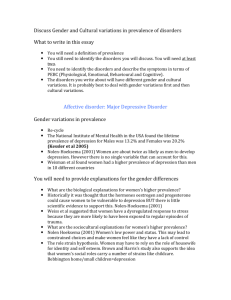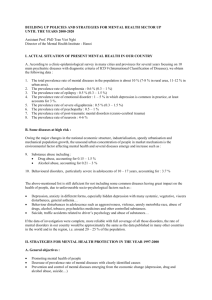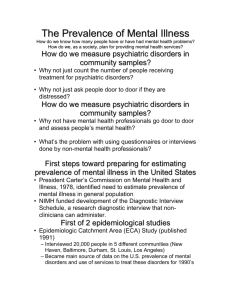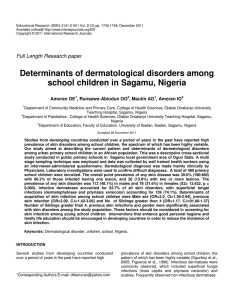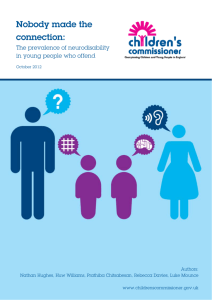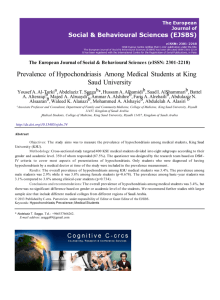Discuss Cultural and Gender Variations in Prevalence of Disorders
advertisement
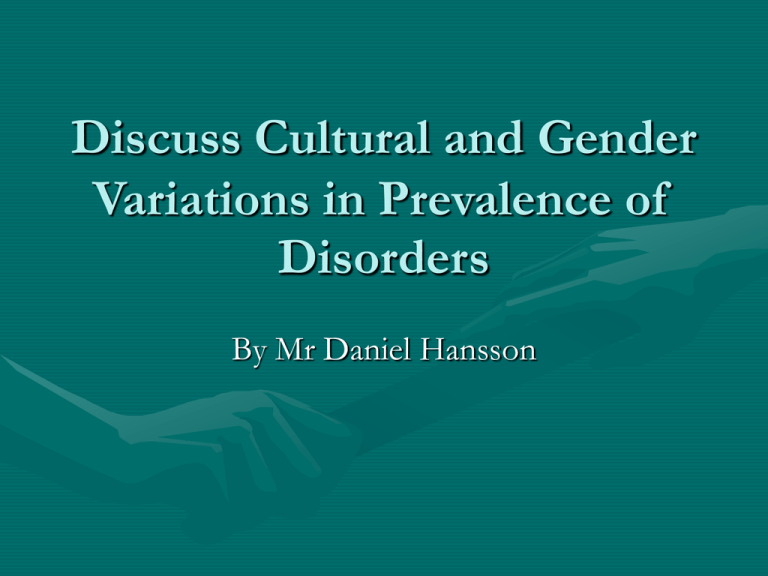
Discuss Cultural and Gender Variations in Prevalence of Disorders By Mr Daniel Hansson Prevalence - Anorexia • Lifetime prevalence of Anorexia nervosa in females is 0.5% • 10 times more likely in females than in males • More common in western societies but is increasing in eastern societies Gender Differences in Prevalence of Depression • Women – 10-25% • Men – 5-12% • The National comorbidity study: 1.7 American woman for every man has experienced at least one episode of depression. Roughly the same ratio has been found in recent studies in nine other countries, including Canada, Brazil, Germany and Japan Cultural Differences in Prevalence of Depression • • • • • • • Seattle, Washington: 6.3 % China: 4 % Verona, Italy: 4.7 % Groningen, Germany: 15.9 % Manchester, United Kingdom: 16.9 % Ankara, Turkey: 11.6 % Nagasaki, Japan: 2.6 % Why are There Cultural Differences in Prevalence of Disorders? • Different cultures have different concepts of what is abnormal behavior • Social problems/pressures and cultural differences may lead to a higher prevalence of disorders in some cultures Different cultures have different concepts of what is abnormal behavior • Okello and Ekblad (2006): In Uganda depression is seen as “illness of thoughts” and not a biological illness. Therefore, it is believed that depressed do not need medicine, unless the disorder is chronic or recurring. • Cooper et al (1972): New York psychiatrists are twice as likely to diagnose patients with schizophrenia than London psychiatrists, who in turn are twice as likely to diagnose mania or depression when shown the same videotaped clinical interviews. • Different countries use different diagnostic tools: E.g. ICD-10, CCMD, DSM-IV-TR • Homosexuality was considered to be abnormal until DSM-III (1980). It is still considered abnormal in many countries. • Unmarried mothers in Britain and political dissidents in the Soviet unions were once confined to institutions for abnormality. The tendency for American black slaves in the 1800s to try flee captivity was considered to be a mental illness. It is claimed that psychiatry also have been used to silence political dissidents in China (e.g. the Falungong movement) Social problems/pressures and cultural differences may lead to higher a prevalence of disorders in some cultures • Becker (1995): After the introduction of television in Fiji, eating disorders in women increased • Suicide is more common in poorer countries • Chiao & Blinsky (2010): Depression is associated with individualism. Individualism is negatively correlated with the frequency of the short allele related to serotonin transporters • In cultures with high levels of community, religiosity, and traditional family roles, depression is less prevalent (e.g. Wu and Anthony 2000) Why are there gender differences in prevalence of disorders? • The are genetic differences between men and women in susceptibility for a disorder • There are cultural differences in expectations of men and women which contribute to different disorders The are genetic differences between men and women in susceptibility to a disorder • Zubenko: Some chromosomes are more likely to contain genes that promote depression. These chromosomes are more common in women than men. There are cultural differences in expectations of men and women which contributes to different disorders • Becker (1995): After the introduction of television in Fiji, eating disorders in women increased • Bulimia and anorexia are most common among upper and middle class Caucasian women.



